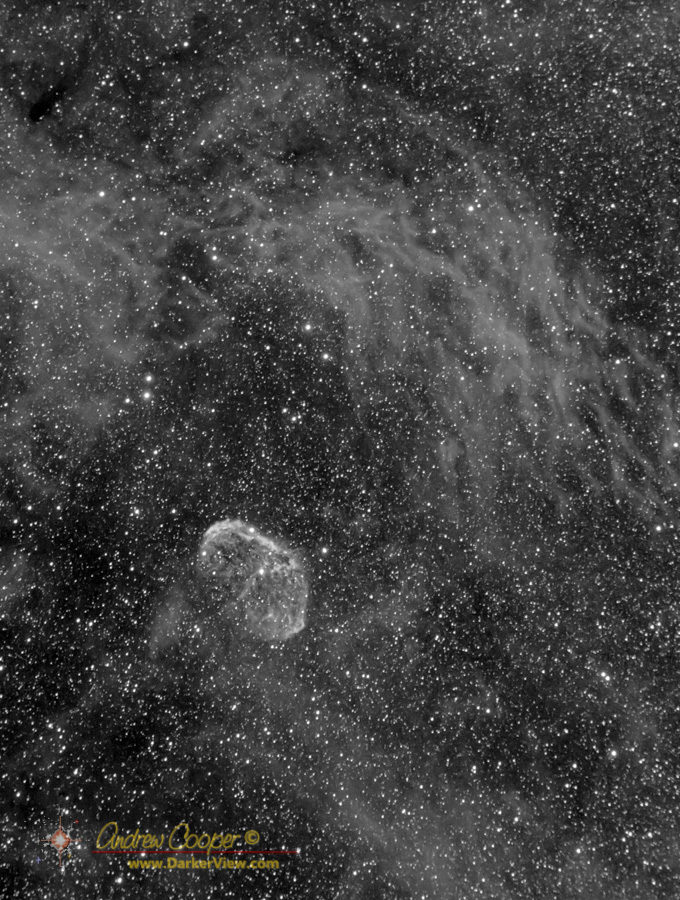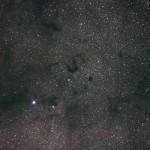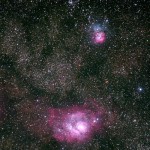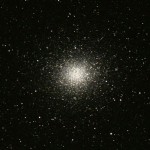
Tag: hydrogen alpha
NGC6888 in Hydrogen Alpha
The North American Nebula
NGC7000 or The North American Nebula is found in Cygnus, just northwest of the bright star Deneb. A huge complex of glowing gas and dark dust the nebula covers and area several times larger than the full moon.
The image here is the sum of 60 individual frames, 30 at 1 minute and 30 more at 5 minutes of exposure taken with a TeleVue 76mm scope and a ZWO ASI1600mm Pro camera through a hydrogen alpha filter.
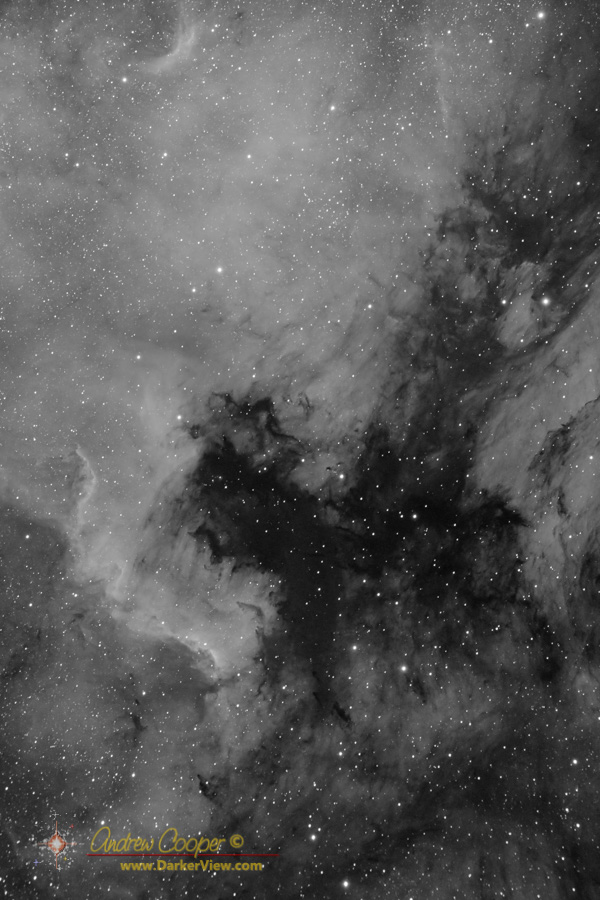
The Veil in Hydrogen Alpha
To allow a wider field of view requires changing optics. In this case putting away the TV-76mm telescope and mounting a vintage Nikkor 180mm f/2.8 ED camera lens.
The Nikkor 180mm is a classic lens, once a favorite of professional film photographers for news and portrait work. Now the lens is out of date, not autofocus, or image stabilized, a bit of very good optics left behind by technology.
Of course, autofocus or image stabilization are useless for astrophotography. With a simple adapter the lens can be mounted to a modern system and used as a fully manual lens in an application where the excellent optical quality can still be appreciated.

The Eagle in Hydrogen Alpha
I have been processing more images from this last week. This one is another classic nebula, the Eagle. The nebula, also known as M16 or NGC 6611 can be found in thick regions of of our galactic core towards the constellation of Serpens.
The eponymous eagle can be seen near the center of the brightest region, a structure of darker material likely held together by the gravity of objects inside it. In this case those objects would be forming stars, or protostars, the result of the dust and gas being drawn together under the influence of gravity.
I have a full set of color filters, once I have had fun re-doing many of these classic nebulae in hydrogen alpha I will probably begin doing full color versions. Color takes a lot more exposure time and much more processing. There are techniques to add H-alpha data to an RGB image to get more definition in the nebula structure, something I have not done and should probably figure out.
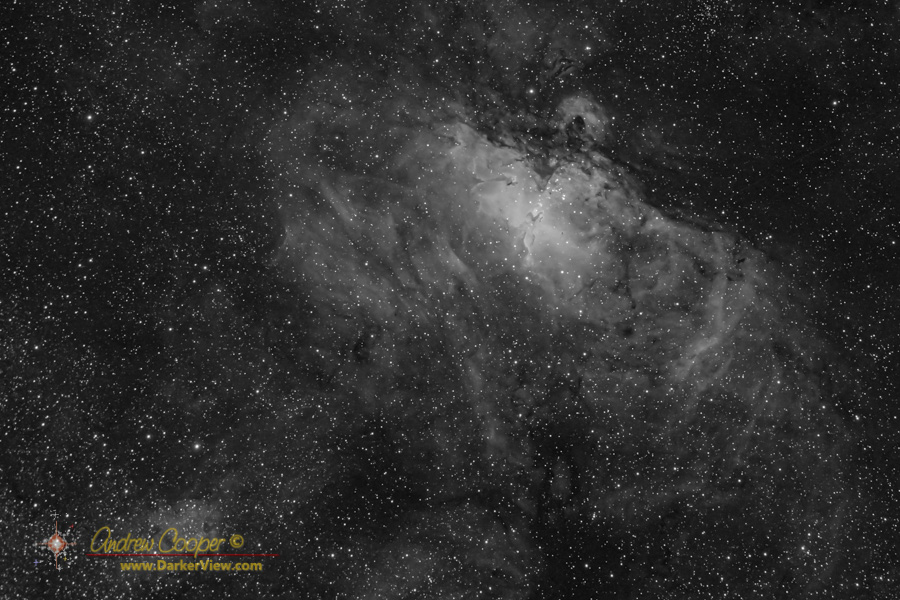
Trifid in Hydrogen Alpha
Next up is the Trifid Nebula in Hydrogen Alpha. This bright nebula is less than two degrees above the Lagoon Nebula as seen in the post a few days ago. Indeed, the bright wisps along the bottom of this shot are the northern bits of the Lagoon.
The Trifid, also known as M20 or NGC6514, is another stellar nursery where star formation is occurring as we watch. The dense gas and dust is being carved into a cavity by the stallar winds of these hot young stars within the nebula creating the bright core cut with dark lanes of dust that we see in this image.
To truly capture this region I need to take at lest one more frame of the area and put together the several resulting frames as a mosaic to cover this large and beautiful nebulae complex.

Sh2-54 in Hydrogen Alpha
Sharpless 2-54 is an often overlooked nebula complex just 2° north of the far more famous Eagle Nebula M16. It is actually part of the same nebula complex the stretches from M17 through M16 to Sh2-54 and beyond. The nebula is much fainter, with not much appreciable without a camera attached to the telescope, thus the complex is not as well known.
The star cluster NGC6604 is found within the nebula, a collection of young stars recently formed from these clouds of gas and dust. In the photo here the cluster is seen just down and right of image center.
Again this image is taken through a hydrogen alpha filter to best show the wisps of glowing gas among the stars.
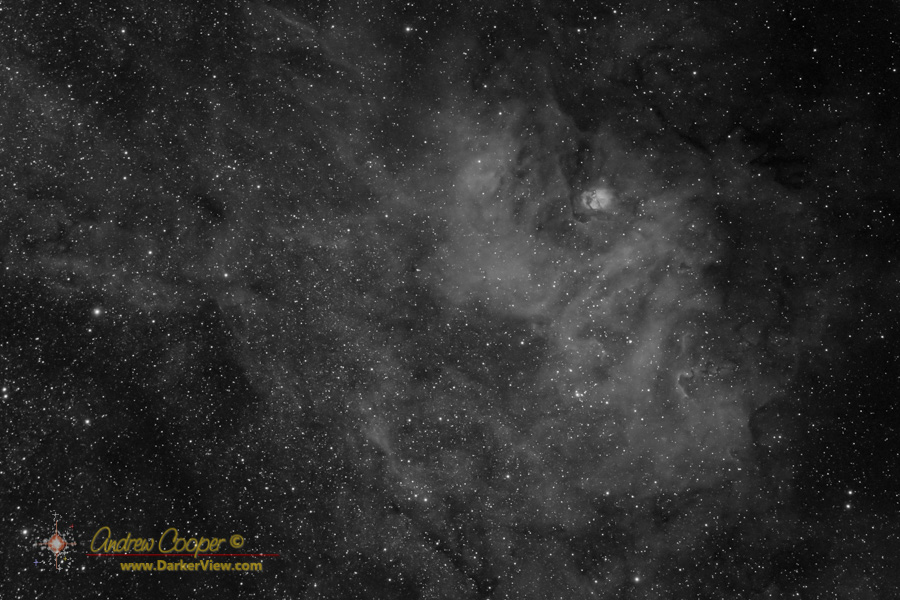
The Lagoon in Hydrogen-Alpha
With summer upon us the central core of the Milky Way galaxy dominates the late evening sky. This allows an astrophotographer a rich selection of targets well placed for shooting all night long.
Among these targets are the large emission nebulae… M17, M16, NGC4628, NGC6334, NGC6357, SH 2-54, and a long list of others. The brightest among these nebulae is M8, the Lagoon nebula, a rich and complex region of star formation, sweeps of gas, and dark globules.
With a new hydrogen-alpha filter added to the camera’s filter wheel it is time to re-image some of these old favorites. The filter is a narrow-band filter allowing through a slice of the spectrum only a few nano-meters wide. The filter pass-band is centered on 656nm deep in the red, the glow of neutral hydrogen gas, this allows sharp images of these glowing nebulae complexes.

DSLR Astrophotography
Digital SLR cameras make surprisingly good astrophotography cameras on bright objects. Good sensitivity, low noise and a convenient form factor make these camera a good choice for shooting the night sky.
One useful modification to the camera is removing the standard IR cutoff filter present in cameras and replacing it with a filter that is tuned to let in more of the red. The new filter should allow light at 656nm, what astronomers call hydrogen alpha, or Hα, the light emitted by neutral hydrogen atoms, the most common element in our universe. This is the red glow that makes the emission nebulae so colorful. An astrophotographer can do the filter change themselves, send it to a specialist who can do the work, or buy an already “modded” camera. Canon has produced two special models specifically for the astrophotography market, the EOS 20Da and 60Da, with this special filter.
Below, one can see the results of using modified, and unmodified cameras and relatively small telescopes…

